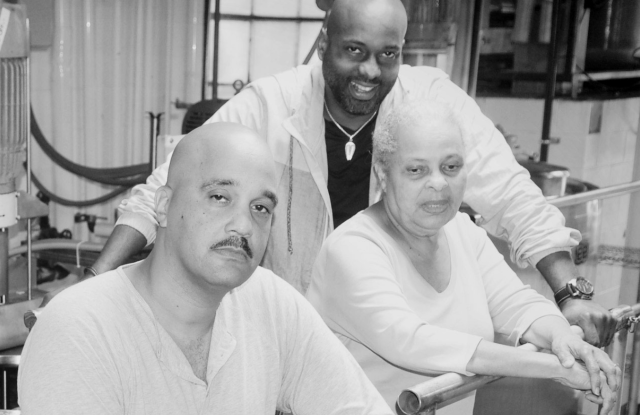Richelieu Dennis and Cashmere Nicole – WWD
Richelieu Dennis
Founder & chair, Essence Ventures; founder, New Voices Fund and New Voices Foundation; founder, Sundial Brands
@richelieudennis
How did you build your brand?
I’ve established a few businesses, but the brand that I built almost 30 years ago — one that has been a consistent part of all my businesses — is Community Commerce. I’ve always fundamentally believed that economic equity is a human right and that businesses have a responsibility to meaningfully invest in the communities where they operate with more than occasional philanthropic efforts or donations, but with meaningful economic opportunities and access.
As much as business in general has tried to separate itself from the societal ills that undermine equality and justice, my family and I have taken a different approach, one that recognizes the role that business can and should play in society and that also uses business as a vehicle to create sustainable economic opportunities in and for underserved communities.
So, after I cofounded Sundial Brands, I developed Community Commerce as the purpose-driven way of doing business that guided our vision, strategy and operations. It resulted in Sundial’s ability to not only build a thriving business, but to also create sustainable community and economic development through entrepreneurship, education and commerce. Whether challenging the divisive constructs of beauty in society and in the beauty industry to open more opportunity for Black consumers and Black-owned beauty companies in retail; providing opportunities to more than 16,000 women in Sundial’s supply chain in Ghana; facilitating tens of thousands of hours of entrepreneurial education and training, as well as fellowship grants, for women and girls of color in the U.S, Liberia and beyond, or creating the $100 million New Voices Fund to support women of color entrepreneurs, the Community Commerce brand has always represented a proven path to merge societal impact and purpose with business and to support people in underserved communities to create lasting economic value for themselves and their communities.
What’s different now?
The goals of Community Commerce remain the same, but what’s different now is that the model is more than a concept and an aspiration. It is proven. I’m encouraged to now introduce new industries and companies to this approach, because we have demonstrated its impact over the course of years.
Upon departing Sundial as chief executive officer in December 2019, I had the opportunity to establish its Social Mission Board, which is giving me an opportunity to help scale the Community Commerce economic impact model across the global organization, as well as provide the insights, strategy and learnings across Unilever. As I’ve been building Essence Ventures as a consumer technology company focused on merging content, community and commerce to meet the evolving cultural and lifestyle needs of people of color, the Community Commerce brand is at the forefront. Our community is largely aware of the impact we made via this approach in the beauty industry, and the expectation is that we will do the same via our businesses now — helping to open economic access, opportunity and equity in Black communities. And we will. That includes not only the businesses we own, but those we’ve invested in. Thirty years ago, we had an idea. Today, we have a solution. That is the difference.
What needs to come next?
More companies need to adopt a Community Commerce approach to maximizing their societal impact and business performance. The two are not mutually exclusive. The responsibility of business in society does not conflict with its responsibility to shareholders and other stakeholders if carried out with purpose, intent and commitment. Never in this generation has this issue been more urgent.
The nation has a new awakening to the inequalities suffered by Black people in America that are rooted in years of legislated, between-the-lines, corporate-sanctioned, ignored and denied affronts. These are not Black America’s problems to solve — they are America’s problems to solve, and that includes its businesses. Any business that says it can’t isn’t trying hard enough and isn’t being truthful enough — and Community Commerce proves it.
Cashmere Nicole
President, ceo and founder, Beauty Bakerie
@beautybakeriemakeup
How did you build your brand?
I was just a girl with big dreams that was also wildly in love with creating. I built this brand in my downtime brick by brick each day while managing a full-time job and full-time motherhood as a single parent.
It would be similar to playing a game of Monopoly and going around the board without instructions unsure of where you’re going and where you’ll end up, winning or losing at each turn, but mostly losing.
What’s different now?
The only difference now is that one day the art that I created in the privacy of my own home became known and admired around the world. I went from being an artist who loved the idea of entrepreneurship to being a ceo leading a team in a matter of months.
There was so much I didn’t know or understand about myself that I was forced to learn on that journey to where we are today. The artist in me felt that it was unfair in some ways to be forced out of my safe cocoon, yet the entrepreneur in me was so ready and remains so enthusiastic about the challenges before me. I now have an amazing community behind me and that support is just powerfully surreal.
What challenges have you faced as a Black entrepreneur that others don’t have to contend with? How did you meet the challenges?
Seeing no other Black entrepreneurs meant I had to come up with the dream of my own volition. My white professor was the one who informed me that I’d have trouble getting calls back for jobs due to my name, and I often did. It took me months or years at times to get calls.
Not having any income delayed the dream. When it came to funding, investors often assumed my brand was only for Black people simply due to the fact that I am Black. It gave me the impression those investors weren’t actually interested in what change my brand could bring to the industry. This made it difficult to get buy-in during the times of tremendous growth and opportunity; they couldn’t see beyond my skin color.
I’ve had others assume that in working alongside my brand that they are superior to me due to their skin color. Dealing with issues like this in private is difficult. There’s no best practice written for these types of situations. Also, when the brand style or creative is copied by a larger brand, it is very damaging to the economic advancement of all of the people who work for the brand and rely on it for their income. These may be people who, like me, would have a very difficult time getting a call for an interview, much less an offer.
What needs to come next?
I think we all believed that the mere presence of opportunities somehow equaled fair access. That’s hardly the case. What needs to come next needs to begin at the top, in the “heart” of who’s at the top. The top of anything, that is — the top of the family, of the business, of the communities, of the country. So with that, I implore myself and others to lead, not just in answering that question, but making it actionable.





